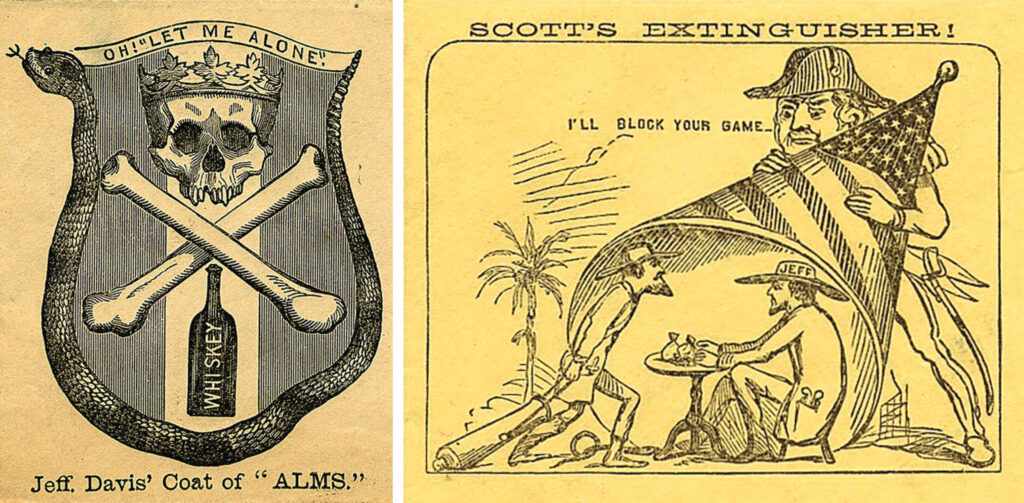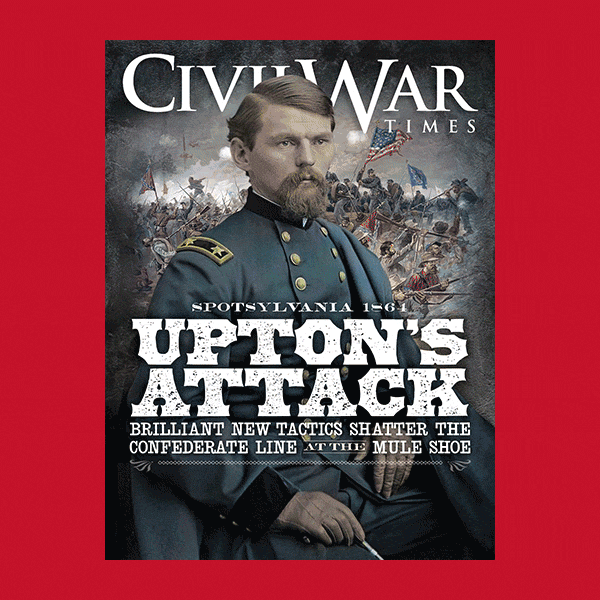A massive amount of correspondence passed between Union armies and the home front. Chaplain Richard Eddy of the 60th New York Infantry, who also served as the regimental postmaster, noted in April 1863 that he “mailed for the regiment 3855 letters during the month.”
The Army of the Potomac comprised 238 infantry regiments, 29 cavalry regiments, and 65 artillery batteries during the Gettysburg campaign, some two months after Chaplain Eddy made his count. If men in all units wrote home at approximately the same rate as the New Yorkers, more than a million letters probably left the army in a single month. The amount of incoming mail can never be known but swelled the total impressively. These numbers attest to the impact of widespread literacy among a national population caught up in life-defining events.
Many letters traveled in envelopes, often called patriotic covers, that reveal important information about political and social attitudes across the North. In Hardtack and Coffee, or the Unwritten Story of Army Life (1887), John D. Billings discussed what he termed the “large number of fanciful envelopes got up during the war.” He heard about “a young man who had a collection of more than seven thousand such, all with different designs,” and had “several in my possession which I found among the numerous letters written home during war-time.” Billings mentioned many with patriotic themes, such as one bearing a portrait of George Washington and the text “A SOUTHERN MAN WITH UNION PRINCIPLES.” A second depicted “the Earth in space, with ‘United States’ marked on it in large letters, and the American eagle above it. Enclosing all is the inscription, ‘What God has joined, let no man put asunder.’” Another had “a negro standing grinning, a hoe in his hand,” related Billings. “He is represented as saying, ‘Massa can’t have dis chile, dat’s what’s de matter’; and beneath is the title, ‘The latest contraband of war.’” Union military figures graced numerous envelopes, as did negative treatments of Jefferson Davis and other Rebels. “[T]he national colors appear in a hundred or more ways on a number,” affirmed Billings, who concluded that the envelopes, “in a degree at least, expressed some phase of the sentiments popular at the North.”
Billings provided an accurate snapshot of patriotic envelopes that circulated in the United States. They reminded citizens of their democratic republic and its Constitution, often deploying Columbia, the 19th century’s feminine personification of the United States, as a symbol of what the founding generation bequeathed to subsequent generations. One envelope placed her opposite Daniel Webster’s ringing phrase “Liberty & Union Now & For Ever.” In another, Columbia employed legalistic wording rather than phrasing likely to make hearts soar: “Proclaim liberty throughout all the land unto all the Inhabitants thereof.” The Founders appeared on envelopes in various ways, most often in the person of George Washington. Other prominent motifs included United States flags, eagles, the Union shield, soldiers and sailors, and famous generals and politicians. Some envelopes were humorous, others serious or even didactic. Many combined multiple popular symbols and texts; one placed Columbia on the left holding a sword and a large U.S. flag, balanced on the right by an eagle, a column with a shield and the word “Union,” a bust of Washington, and a copy of the Constitution.
Ubiquitous allusions to “Union” accompanied various symbols. Representative envelopes offered “Union Forever” on an embossed flag, “Union” surrounded by the names of the loyal states, and “Union” in the middle of a large star. Envelopes catered to individual states, typified by one highlighting Columbia, her hands on the U.S. flag and the seal of the state of New York, with “LOYAL TO THE” in white letters behind her and “UNION” in large red, white, and blue letters to her right. On one striking envelope, a locomotive with “Union For Ever” emblazoned on its smokestack smashes through Rebels along a railroad. Should the letter’s recipient miss the obvious message, a caption explained: “The Union locomotive clearing the Secession track.”

(National Postal Museum, Smithsonian Institution)
Jefferson Davis turned up frequently as the principal traitor seeking to destroy the Union—sometimes with comical plays on words as part of the message. One example presents the Confederate president dangling from a gallows with text above and below: “Jeff. Davis, ‘President’ of Traitors, Robbers, and Pirates; the Nero of the 19th century.”; and “On the Last ‘Platform’ of the Southern Confeder-ass-y ‘Rope, Beam & Co.,’ Executors.” A second envelope used images in a pair of ovals—on the top, “Jeff the Dictator As He Is,” a booted and spurred figure holding a sword and with a skull-and-crossbones flag behind him; on the bottom, “Jeff the Dig-Tater-er As He Should Be,” a barefoot and shirtless figure digging with a hoe while an enslaved man whips him.
Relatively few envelopes dealt directly with either emancipation or African Americans, but those that did usually resorted to overtly racist texts and images. Some catered to Democrats who opposed emancipation, including one caricaturing a Black man with large red lips captioned, “The Cause of All Our Troubles.” Others dealt with contrabands (refugees)—a man shining a shoe and alluding to General Benjamin F. Butler, “By golly Massa Butler, I like dis better dan workin’ in de field for old Secesh massa.”; a black couple in grotesque poses with the caption, “Bress de Lor, we am Contraban.”; and a White man holding a Black child, “Him fader’s hope / Him moder’s joy, / Him darling little / Contraband Boy.”
Surviving evidence does not indicate what percentage of the United States mail traveled in patriotic envelopes. Some political and military figures prominent early in the war appear more frequently than those whose fame came later, which suggests the envelopes declined in popularity as the war dragged on. The Union’s first real martyr, Col. Elmer Ellsworth, was a subject far more often than Ulysses S. Grant or William Tecumseh Sherman. Many of the covers may have been saved rather than used—collected, as with the man with more than 7,000 mentioned by John D. Billings. For current students of the war, the envelopes indisputably offer valuable information about politics and culture in the wartime North.


